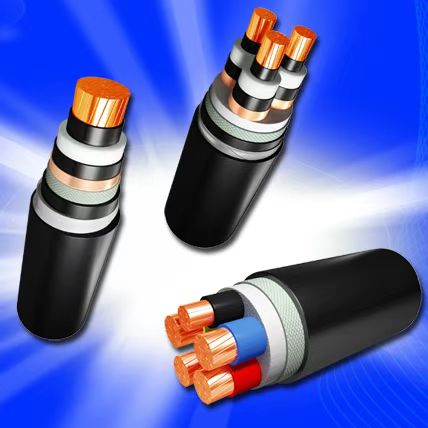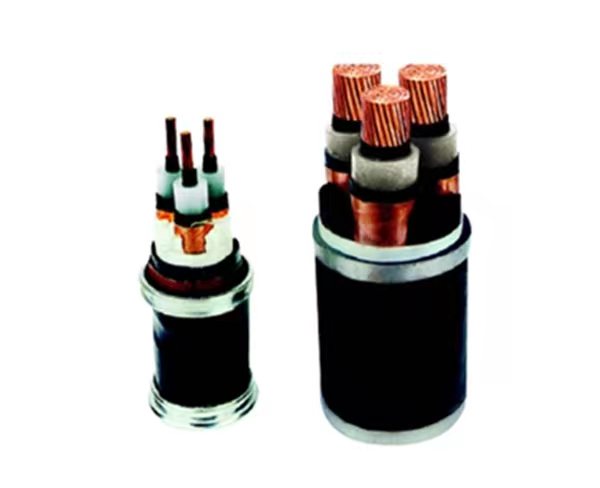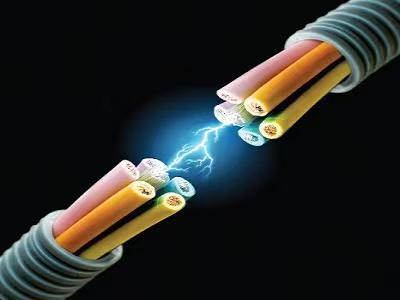Define
Power cable are used to transmit and distribute electric energy. Power cable are often used in urban underground power grids, power generating lines of power stations, internal power supply of industrial and mining enterprises, and underwater transmission lines across rivers and seas.

Basic structure of power cable
The innermost part of the power cable is the wire core (conductor). The outside of the wire core is phase insulation and packing, and the outside is three-phase integrated insulation. The outer part of the integrated insulation is lead envelope, and the outer part of the lead envelope is a protective layer such as steel armor and PVC sheathed.
For example, the structure of YJQOZ220/1×800 cross-linked cable from the inside out is: conductor, semi-conductive tape, conductor shielding, insulation, insulation shielding, longitudinal water-blocking layer, lead sleeve, asphalt, PVC tape, PVC sheath and semi-conductive coating.
Allowable minimum bending radius of the cable
The minimum bending radius of the cable is related to its diameter, and the allowable bending radius is expressed as a multiple of the cable diameter no less than 15 times for the three-core oil-immersed insulated cable and 25 times for the single-core cable. The outer length of oil-soaked paper insulated lead-covered cable is 30 times when it is above 40mm and 25 times when it is below 40mm. Rubber, plastic insulated cable is 10 times.
According to voltage level division, which several levels of cable
According to the custom at home and abroad, the cable is divided into low-voltage cable, medium-voltage cable, high-voltage cable and ultra-high-voltage cable, that is, the voltage is 35kV and below for low-voltage cable; Medium voltage cable above 35kV — 69kV; 110-220kV high voltage cable; More than 220kV is called ultra high voltage cable.
The role of cable shield and ground wire
The shielding layer is divided into inner shielding and outer shielding. They are to make the cable conductor and the insulation layer, the cable insulation layer and the inner sheath have good contact, eliminate the increase in the surface electric field strength caused by the conductor surface and the inner sheath surface is not smooth, generally on the surface of the conductor is covered with metallic paper tape or semiconductor paper tape.
The cable is installed with ground wire, mainly to protect the insulation breakdown fault occurs in the cable or through a large fault current in the wire core, the induced voltage of the metal sheath may make the insulation breakdown, cause arc, the metal sheath burn through.
What is the structure and function of the cable sheath
The cable outer sheath is generally composed of an inner lining, an armored layer and an outer covering layer. The lining is located between the armored layer and the inner sheath and its function is to protect the inner sheath from corrosion and to prevent the inner sheath from being damaged by the armored layer when the cable is bent.
Armored layer outside the lining layer, its function is to reduce the effect of mechanical force on the cable, so that the mechanical force on the cable is borne by the armored layer. The outer covering layer is outside the armored layer and its function is to prevent the armored layer from being eroded. Therefore, the role of the cable outer sheath is to protect the inner sheath from external influences and mechanical damage.
Power cable fault characteristics
According to the operation or preventive test of power cable, the cable, cable head and intermediate box show different characteristics of insulation damage, which can be divided into three types: blasting fault, breakdown fault and operation fault.
Shooting problems
In industrial and mining enterprises, the operation of power cables, because of various factors, the insulation is severely damaged, the event of tripping. It’s called cable firing.
The characteristics of this kind of fault are: cable fault points are mostly lead pack or copper rupture, external deformation is not the same degree; Cable fault properties are often manifested as two-phase short-circuit grounding or two-phase line break and grounding, the grounding resistance is usually small, dissecting the fault point, can be found arc breakdown carbonization point or tree carbon channel and cracks.

Breakdown faults
In practice, cable insulation damage triggered by preventive tests is commonly called cable breakdown. Such faults occur at DC test voltage, and the insulation damage is electrical breakdown. The address is usually without lead or copper, and there is no significant deformation outside (mechanical wound outside).
Cable breakdown faults are mostly simple grounding faults. The grounding faults are high. Dissecting fault points, insulation materials have no carbonization points, but carbon holes and water branch aging structures can be found by the instrument. For cable breakdown faults, especially some high-resistance grounding cable breakdown faults, the difficulty of testing is ranging.
Operation problem
It refers to the factory power system in operation, cable feed out line, motor, transformer cable lead, the high voltage secondary loop present voltage fluctuations or find the grounding signal, sweep away the possibility of other power components and conclude the cable fault.
The pole of cable operation fault is the cable firing (such as two points of grounding caused by inter-phase short circuit); Another some operating faults are developed into cable breakdown faults (such as cable aging, insulation defects, etc.) when doing stop point inspection because of voltage resistance.
There are also some cable operation faults because the cable outlet line device is not in the right position. After the cable power failure, the insulation resistance measurement and DC voltage test can be properly tested, and then the cable is put into the system.
There are two kinds of grounding fault factors for cable operation:
1. Because the running time of the cable is longer, the insulation layer shows natural aging
2. In a corrosive environment, the cable sheath is quickly damaged, and the corrosive gas intrudes into the insulation layer to deteriorate it. Regardless of the aging or deterioration of cable insulation, its breakdown voltage will decrease, and eventually lead to the decrease of additional power frequency voltage.
Selection principle of power cable
1. Aluminum alloy conductor should not be selected for cables with voltage grade above 1kV.
2. Cross-linked polyethylene or PVC extruded insulation type should be used for low-voltage cables. When environmental protection requirements are met, PVC insulated cables should not be used.
3. High voltage AC cables should be insulated with XLPE.
4. Mobile electrical equipment and other often bend and move or have higher flexibility requirements of the loop should be used rubber insulation cable.
5. According to the requirements of the insulation type, cross-linked polyethylene or ethylene propylene rubber insulation cable with radiation resistance should be selected for the radiation site.
6. 60℃ above high temperature places should be selected according to the high temperature and its duration and insulation type requirements, heat resistant polyvinyl chloride, crosslinked polyethylene or ethylene propylene rubber insulation and other heat resistant cables; Mineral insulated cables should be used in high temperature environment above 100℃. Polyvinyl chloride insulated cables should not be used in high temperature places.
7. When the annual minimum temperature is below -15 ° C, cross-linked polyethylene, polyethylene and cold-resistant rubber insulated cables should be selected according to the low temperature conditions and insulation type requirements. PVC insulated cables should not be used in low-temperature environment.
8. In crowded places or places with low toxicity requirements, halogen-free insulated cables such as crosslinked polyethylene or ethylene propylene rubber should be used instead of polyvinyl chloride insulated cables.
9. For the crosslinked polyethylene insulated cables of 6kV and above, the inner and outer semi-conductive shielding layer and insulating layer of the three-layer co-extrusion process characteristics should be selected.
10. Ac system single-core power cable, when it is necessary to strengthen the cable resistance to external force, should choose non-magnetic metal armor layer, not without non-magnetic effective treatment of steel armor.
11. The submarine cable should be galvanized steel wire, stainless steel wire or copper armored with good corrosion resistance, rather than aluminum armored.
12. Fire control distribution lines shall meet the needs of continuous power supply in case of fire, and their laying shall comply with the following requirements:

For open application (including laying in the ceiling), metal conduit or closed metal groove box should be worn for protection, and fire protection measures should be taken for the metal conduit or closed metal groove box.
When flame retardant or fire-resistant cables are used and laid in cable Wells and trenches, metal conduit or closed metal groove box protection is not required; When using mineral insulated non-combustible cable, it can be directly applied.
For dark application, the tube should be worn and laid in a non-combustible structure, and the thickness of the protective layer should not be less than 30mm.
Fire distribution lines should be laid separately from other distribution lines in different cable Wells and ditches; If it is really difficult to lay it in the same cable well and ditch, it should be arranged on both sides of the cable well and ditch respectively, and the fire control distribution line should use mineral insulated non-combustible cables.